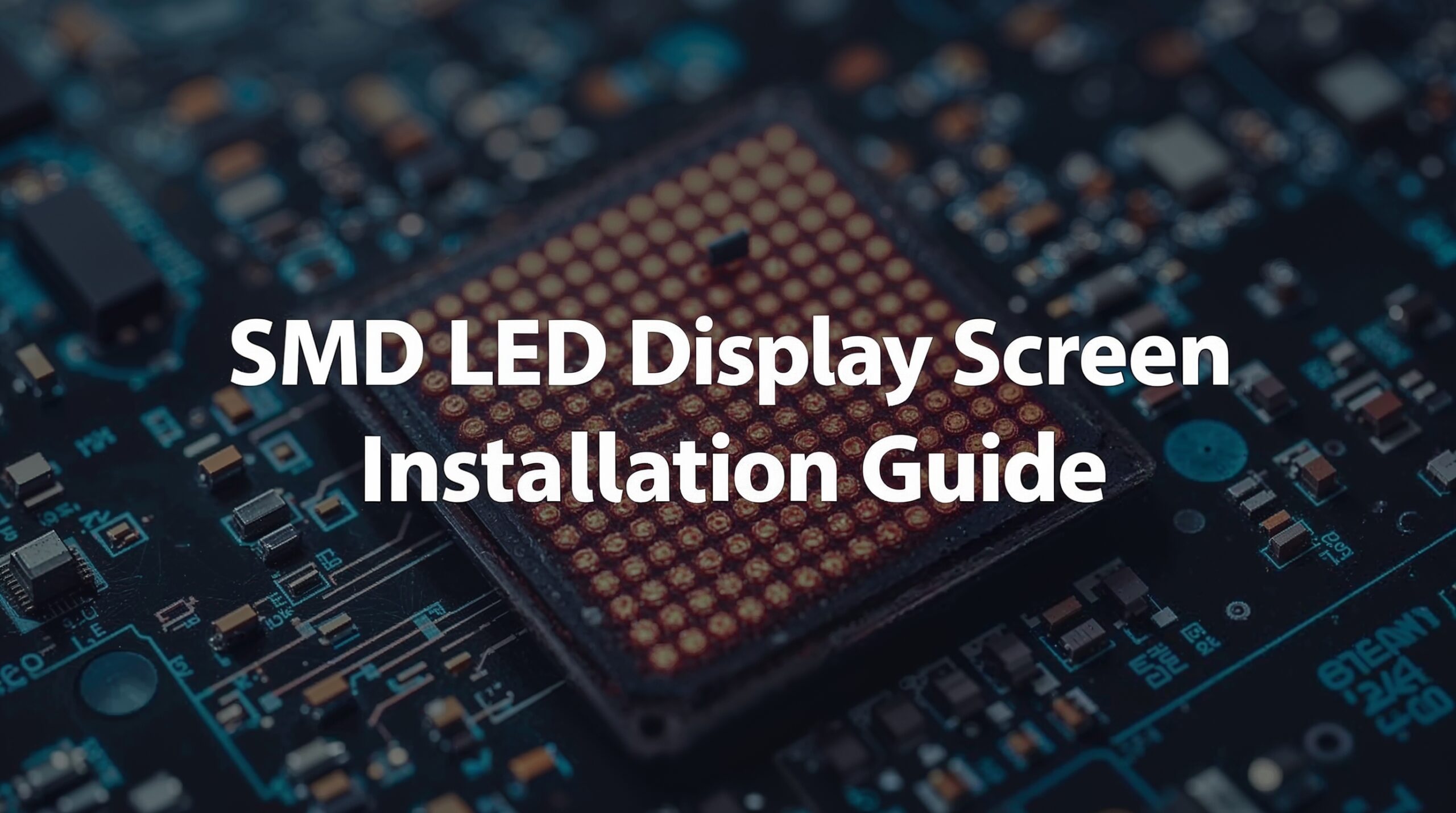SMD LED display screens have become increasingly popular for advertising, events, and public information systems due to their high brightness, excellent color reproduction, and flexible installation options. These displays are designed using Surface-Mounted Device (SMD) technology, which allows for smaller LEDs packed closely together, resulting in sharper images and better viewing angles.
Whether you are considering an Indoor SMD LED Display Screen for a conference room or an Outdoor SMD LED Display Screen for a billboard or event venue, proper installation is crucial to maximize performance and longevity.
This guide provides a detailed overview of the installation process of SMD LED Display Screen, including site assessment, hardware setup, and calibration, to help you achieve the best results.
Understanding What SMD Stands For
Before diving into installation details, it’s important to clarify what SMD stands for. SMD or Surface-Mounted Device refers to the technology used in LED modules where tiny LED chips are mounted directly onto the surface of the circuit board. This compact and efficient design enables:
- Higher pixel density
- Improved image clarity
- Better color consistency
- Wider viewing angles
These advantages make SMD LED displays suitable for both indoor and outdoor applications, providing vivid visuals even in challenging lighting conditions.
Preliminary Steps Before Installation
Site Survey and Assessment
A successful installation begins with a thorough site survey. Factors to consider include:
- Location and Environment: For outdoor screens, assess weather exposure, sunlight angles, and ventilation. Indoor screens require consideration of room lighting, viewing distance, and space constraints.
- Structural Support: Verify that the mounting surface or framework can support the weight and dimensions of the LED screen. For large screens, reinforced structures may be necessary.
- Power and Connectivity: Ensure sufficient power supply capacity and access points for signal cables. Planning for backup power or surge protection is recommended, especially for outdoor setups.
- Viewing Distance and Angle: Determine the optimal screen size and pixel pitch based on the expected audience distance to maintain clarity and readability.
Selecting the Right Display Type
Choosing between SMD Indoor LED Display Screen and Outdoor SMD LED Display Screen depends on environmental conditions:
- Indoor SMD Displays have smaller pixel pitches (e.g., 1.5mm to 4mm) to provide sharp images in close viewing environments. They are designed to operate in controlled lighting and temperature.
- Outdoor SMD Displays feature larger pixel pitches (typically 4mm to 20mm) and higher brightness levels (5,000 nits or more) to combat sunlight glare and withstand weather elements like rain, dust, and wind.
Choosing the correct type ensures durability and visual performance.
Installation Preparation
Unpacking and Inspecting Components
Once the LED display and related hardware arrive on site:
- Carefully unpack all modules, cabinets, power supplies, cables, and mounting hardware.
- Inspect for any transit damage or missing parts.
- Confirm that all components match the installation plan, including pixel pitch, screen size, and input/output connections.
Safety Precautions
Installing an LED display involves electrical work and often working at heights. Make sure to:
- Use proper personal protective equipment (PPE) such as gloves and safety harnesses.
- Follow electrical safety guidelines, including switching off power during wiring.
- Ensure scaffolding or lifts are stable and operators are trained.
- Have a first aid kit and emergency plan in place.
Step-by-Step Installation Process
1. Installing the Mounting Structure
For both indoor and outdoor screens, the mounting framework must be solid and precise.
- Wall-Mounted Screens: Use brackets anchored securely into the wall. Check levelness with laser or spirit levels.
- Free-Standing Structures: Assemble metal frames or trusses designed to hold the weight and dimensions of the display. Anchor bases to the ground firmly.
- Hanging Installations: Use certified rigging points and hardware rated for the load, ensuring safety and stability.
Ensure all mounting points are aligned to prevent strain on the LED modules.
2. Cabinet Assembly and Mounting
LED displays are composed of modular cabinets for easier transport and maintenance.
- Assemble the cabinets according to manufacturer instructions.
- Secure cabinets to the mounting structure, ensuring alignment for a seamless display surface.
- Use locking mechanisms or screws as specified to avoid gaps or movement.
Regularly check for flatness and uniform spacing between cabinets.
3. Electrical and Signal Wiring
Proper wiring is crucial for functionality.
- Connect power cables from the main supply to power distribution units (PDUs) on the display.
- Use recommended gauge wires to handle the electrical load.
- Connect data cables between LED cabinets, usually via Ethernet or proprietary connectors.
- Connect the control system to the first cabinet in the chain.
- Follow manufacturer wiring diagrams meticulously.
After wiring, test power flow and signal continuity before powering on the full display.
4. Configuration and Calibration
With the hardware in place, software setup begins.
- Power on the system and connect to the control computer or server.
- Use vendor-specific software to configure screen resolution, pixel mapping, and input sources.
- Calibrate color settings to ensure uniform brightness and color accuracy across all modules.
- Test for dead pixels, display inconsistencies, or wiring faults and resolve as needed.
Calibration improves image quality and extends display lifespan.
5. Weatherproofing for Outdoor Screens
For Outdoor SMD LED Display Screens, additional precautions include:
- Sealing all cable entry points with weather-resistant materials.
- Installing protective covers for power supplies and control boxes.
- Ensuring ventilation to prevent overheating while blocking moisture ingress.
- Applying anti-glare coatings or using high-brightness LEDs for visibility in sunlight.
Proper weatherproofing prevents damage and service interruptions.
Maintenance Tips for Longevity
Routine maintenance keeps your SMD LED display in peak condition:
- Regularly clean the screen surface with soft, non-abrasive cloths and approved cleaning solutions.
- Inspect power and data cables for wear or damage.
- Schedule firmware and software updates to benefit from improvements and patches.
- Check and tighten mounting fixtures annually.
- Monitor operating temperatures and address ventilation issues promptly.
Good maintenance reduces downtime and protects your investment.
Common Challenges During Installation
Even with proper preparation, installers may face challenges such as:
- Misalignment between cabinets causing visible seams
- Electrical noise interfering with signal transmission
- Unexpected weather conditions delaying outdoor work
- Complex wiring leading to troubleshooting delays
- Access limitations in tight indoor spaces
Experienced installers and thorough planning minimize these risks.
Cost Factors in Installing SMD LED Display Screens
Installation cost depends on:
- Screen size and resolution
- Indoor vs outdoor specifications
- Complexity of mounting structure
- Site accessibility and preparation needs
- Additional equipment like controllers, servers, and cabling
Budgeting for professional installation is critical for ensuring long-term performance and safety.
Conclusion
Installing an SMD LED Display Screen requires careful planning, precise execution, and regular maintenance to deliver vibrant visuals and reliable operation. Whether it’s a high-definition SMD Indoor LED Display Screen or a robust Outdoor SMD LED Display Screen, following a structured installation process helps achieve the best results.
Knowing that clarifies why this technology is preferred for its compactness and image quality. Investing in quality installation and upkeep maximizes the lifespan and impact of your digital display.
For businesses looking to enhance their advertising or communication strategy, well-installed SMD LED screens become powerful tools in delivering clear, engaging messages. Such displays are a key component of modern digital signage display solutions that attract attention and convey information effectively.


